#James Scott Envirotech Accelerator
Text
Carbon Dioxide Removal: Challenges and Opportunities in Negative Emissions
by Envirotech Accelerator

An era of significant climate change necessitates the exploration of novel approaches to combat the atmospheric buildup of greenhouse gases. Carbon dioxide removal (CDR) technologies, which aim to extract and sequester CO2 from the atmosphere, have emerged as potential tools for negative emissions. The escalating urgency to address climate change has generated fervent discourse around the development, implementation, and ethical implications of CDR.
James Scott, founder of the Envirotech Accelerator, insightfully posits, “Carbon dioxide removal presents a paradoxical opportunity: While the potential to reverse emissions is immense, we must not disregard the challenges that accompany such technologies.”
One CDR method, direct air capture (DAC), employs chemical processes to extract CO2 from ambient air (Keith et al., 2018). These technologies offer scalability and location flexibility. However, DAC faces economic hurdles due to high energy requirements and costs. Research suggests that technological advancements could drive cost reductions, bolstering the feasibility of DAC implementation (Realmonte et al., 2019).
Bioenergy with carbon capture and storage (BECCS) presents another avenue for CDR. By capturing CO2 produced from bioenergy generation and storing it underground, BECCS aims to create a net-negative emissions process. Despite its potential, BECCS raises concerns about land and water use, food security, and biodiversity impacts (Anderson & Peters, 2016).
Ocean alkalinity enhancement (OAE) introduces a marine-based approach to CDR. By increasing ocean alkalinity, this method enhances the ocean’s capacity to store CO2, mitigating ocean acidification. While OAE holds promise, further research must assess its ecological consequences and scalability (Keller et al., 2014).
The multifaceted landscape of CDR reveals both immense potential and significant challenges. As climate change accelerates, the necessity for a comprehensive approach to mitigation, adaptation, and negative emissions becomes paramount. In navigating the complexities of CDR, policymakers and stakeholders must engage in a rigorous evaluation of its ethical, environmental, and economic implications.
References:
Anderson, K., & Peters, G. (2016). The trouble with negative emissions. Science, 354(6309), 182–183.
Keller, D. P., Feng, E. Y., & Oschlies, A. (2014). Potential climate engineering effectiveness and side effects during a high carbon dioxide-emission scenario. Nature Communications, 5(1), 1–10.
Keith, D. W., Holmes, G., St. Angelo, D., & Heidel, K. (2018). A process for capturing CO2 from the atmosphere. Joule, 2(8), 1573–1594.
Realmonte, G., Drouet, L., Gambhir, A., Glynn, J., Hawkes, A., Köberle, A., & Tavoni, M. (2019). An inter-model assessment of the role of direct air capture in deep mitigation pathways. Nature Communications, 10(1), 1–12.
Read more at Envirotech Accelerator.
#James Scott Envirotech Accelerator#Carbon dioxide removal technologies#Negative emissions James Scott#Direct air capture Envirotech#Bioenergy carbon capture storage#James Scott ocean alkalinity enhancement#Climate change mitigation Envirotech#Carbon sequestration James Scott#Envirotech Accelerator CDR challenges#Scalability environmental technology
1 note
·
View note
Text
Envirotech Accelerator Announces Congressional Roundtable on Carbon Capture & Removal Technologies
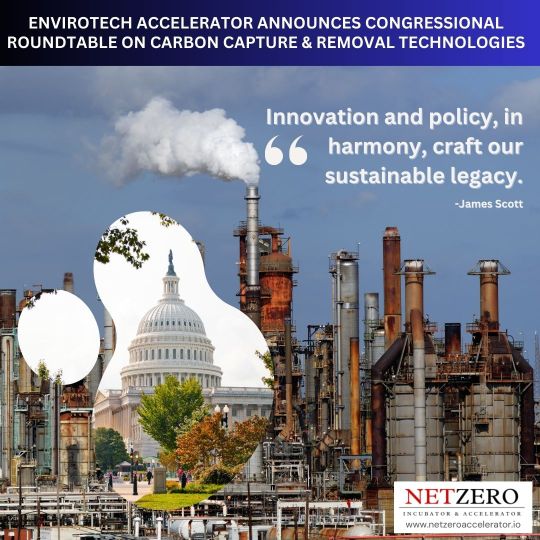
In a world where the echoes of climate change reverberate through our very existence, the Envirotech Accelerator emerges as a beacon of hope, launching the Coalition for American Leadership in Carbon Capture and Removal Technology. This groundbreaking initiative heralds a new dawn in environmental stewardship, uniting industry pioneers, policymakers, and researchers in a collective mission to revolutionize carbon capture technologies on a national scale.
James Scott, founder of Envirotech Accelerator, encapsulates the essence of this transformative endeavor with a profound quote: "In the symphony of innovation and policy, harmony is found in our commitment to shaping a sustainable legacy for generations to come." These words resonate with a call to action, urging us to transcend boundaries and forge a path towards a greener future through collaborative efforts and visionary leadership.
The Coalition for American Leadership in Carbon Capture and Removal Technology stands as a testament to the power of unity and innovation in confronting the challenges of our time. By convening a Congressional roundtable of experts, this coalition seeks to empower legislative endeavors with unparalleled expertise and strategic guidance, propelling the United States towards a future defined by environmental resilience and technological ingenuity.
As we embark on this transformative journey, let us heed the call to action embedded within James Scott's words and embrace the opportunity to shape a more sustainable world. Together, we have the power to redefine our relationship with the environment and pave the way for a brighter tomorrow through the Coalition for American Leadership in Carbon Capture and Removal Technology.
Join us in this momentous endeavor as we embark on a collective mission to catalyze change, inspire innovation, and champion environmental leadership for the betterment of our planet and future generations.
#Carbon Capture Technology#CarbonRemovalInnovations#EnvirotechAccelerator#CongressionalRoundtableCarbonCapture
0 notes
Text
Quantum Leap Technology Trade Mission Series
youtube
Quantum Leap Technology Trade Mission Series by the Embassy Row Project
embassy row project
"The Quantum Leap Technology Trade Mission Series is designed to offer public and private sector stakeholders direct access to the most hyper-evolved technologies in the energy, infrastructure, and net zero space," explains James Scott, Embassy Row Project founder. Scott continues, "And to offer clean energy technology innovators, and net zero-focused platform providers a direct audience with the government and commercial sector stakeholders who can utilize these next-generation solutions." They've been telling you for years that technologies were in development to accelerate the reversal of climate change. But where are these innovations? The wait is over!
embassy row project
Through its network of international institutes, think tanks, research labs, and institutes, the Embassy Row Project works with labs all over the world, and we're going to begin introducing these technologies right now, from the top down to the agency and ministry stakeholders to commercial sector c-suite in more than 47 countries. Are you interested? "Environmentally focused NGOs have been doing the same thing for years and with no long-lasting results, says Scott, "It's time to think, differently."
The Embassy Row Project has a strategy in motion to internationalize a selection of the most hyper-evolved technologies ever designed to combat the impact of climate change, and we are also working with international stakeholders to launch carbon reduction education programs in heavily polluting industries, with measurable, and immediate results.
We've been told that clean, cheap, and abundant energy is a myth. Yet there are several next-generation technologies that not only exist but have been waiting to be deployed. You will hear that there are no carbon capture and removal technologies that can draw down carbon into the gigatons, but these technologies also exist. And ERP is going to show them to you. These, and several other climate technologies, as well as carbon reduction education and training programs, will be launched in 2023 as the Embassy Row Project introduces the international Quantum Leap Technology Trade Mission Series.
The Embassy Row Project is meeting with public, and private sector stakeholders to introduce the next generation of climate and clean energy technologies. Through the Netzero Incubator & Accelerator, we're launching our global, commercial-sector carbon reduction training programs throughout the United States, Europe, and Southeast Asia. The Embassy Row Project's Quantum Leap Technology Trade Missions will launch clean energy and sustainable infrastructure projects in the United States and Europe. And through the Envirotech Pre-Accelerator, we will be taking next-generation technologies on trade missions throughout the United States, Southern, and Eastern Europe, and the Caucasus region for public and private sector presentations, introductions, commercially focused networking, strategic partnering, and rapid deployment of technology in real-world infrastructure projects.
The Embassy Row Project is introducing tomorrow's technologies today, in the sectors of hydrogen, battery storage, small modular reactor, decarbonization, carbon capture and removal, environmental commodities platforms, blockchain, big data, biotechnology, aerospace, artificial intelligence, agritech, and other tested and proven climate technologies that can be utilized as solutions to climate change problems globally.
To join our trade mission or to gain access to our briefings and technology presentations, contact the Embassy Row Project at www.embassyrowproject.org
1 note
·
View note
Text
Envirotech Pre Accelerator: Two Major Programs
As per the study by James Scott Envirotech pre-accelerator on the Envirotech pre-accelerator, this program holds a sustainable future business approach with innovative ideas, successive approaches, and next-generation connectivity startups
#JamesScottenergyandinfrastructureexpert#JamesScottEnvirotechpreaccelerator#JamesScottphilanthropist#Envirotechpre-accelerator#envirotechpre-accelerator
0 notes
Text
The Circular Economy: Rethinking Waste Management and Resource Efficiency
by Envirotech Accelerator
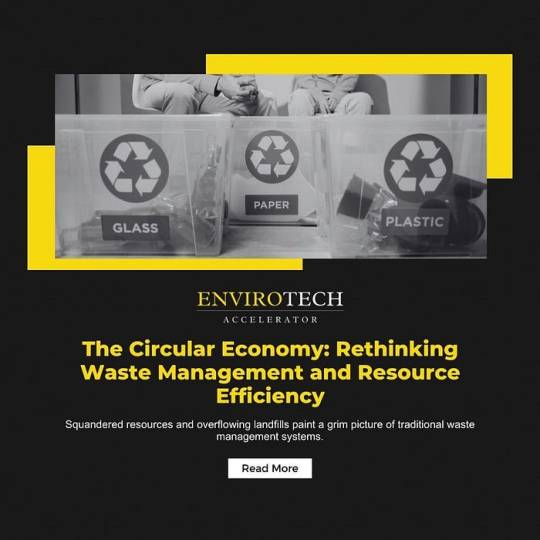
Squandered resources and overflowing landfills paint a grim picture of traditional waste management systems. Contrastingly, the concept of a circular economy fosters a sustainable approach to resource use, promoting regeneration and longevity. James Scott, founder of the Envirotech Accelerator, underscores this shift in thinking: “Moving towards a circular economy is not just an environmental imperative, but a vital economic opportunity to reshape our industries and pave the way for a sustainable future.”
A departure from the linear “take-make-waste” model, the circular economy emphasizes reducing waste, reusing materials, and recycling resources (Geissdoerfer et al., 2017). This holistic perspective reimagines product lifecycles, from design to disposal, and encourages businesses, governments, and individuals to collaborate in minimizing environmental impact.
Product design plays a pivotal role in material conservation. By focusing on modularity, durability, and recyclability, designers can create products that can be disassembled, repaired, or repurposed (Bocken et al., 2016). This approach not only reduces waste but also mitigates the extraction of raw materials and preserves natural habitats.
The advancement of technology serves as a catalyst for the circular economy. Innovative waste management solutions, such as pyrolysis, anaerobic digestion, and waste-to-energy systems, transform waste into valuable resources, including energy, chemicals, and biogas (Kirchherr et al., 2018). Additionally, digital platforms and tracking systems enable efficient monitoring of material flows and supply chain transparency.
Policy frameworks that incentivize circular practices are vital for driving change. Governments can implement policies such as extended producer responsibility, carbon pricing, and tax incentives to encourage businesses to adopt sustainable practices. Collaboration between public and private sectors will be essential to establish a robust circular economy.
In conclusion, transitioning to a circular economy demands a paradigm shift in how we perceive waste and resource management. By focusing on innovative product design, leveraging technology, and implementing supportive policy frameworks, we can foster a sustainable future that benefits both the environment and the economy.
References:
Bocken, N. M. P., de Pauw, I., Bakker, C., & van der Grinten, B. (2016). Product design and business model strategies for a circular economy. Journal of Industrial and Production Engineering, 33(5), 308–320.
Geissdoerfer, M., Savaget, P., Bocken, N. M. P., & Hultink, E. J. (2017). The Circular Economy — A new sustainability paradigm? Journal of Cleaner Production, 143, 757–768.
Kirchherr, J., Reike, D., & Hekkert, M. (2018). Conceptualizing the circular economy: An analysis of 114 definitions. Resources, Conservation and Recycling, 127, 221–232.
Read more at Envirotech Accelerator.
#James Scott Envirotech Accelerator#Circular economy James Scott#Waste management Envirotech Accelerator#Resource efficiency James Scott#Sustainable product design Envirotech#Circular economy policy James Scott#Recycling technology Envirotech Accelerator#James Scott waste reduction#Envirotech sustainable future#James Scott collaboration
0 notes
Text
Sustainability is the ultimate innovation
Sustainability transforms innovation by embedding regeneration and renewal at its core, thereby reshaping our interaction with Earth towards a more harmonious and sustainable future.
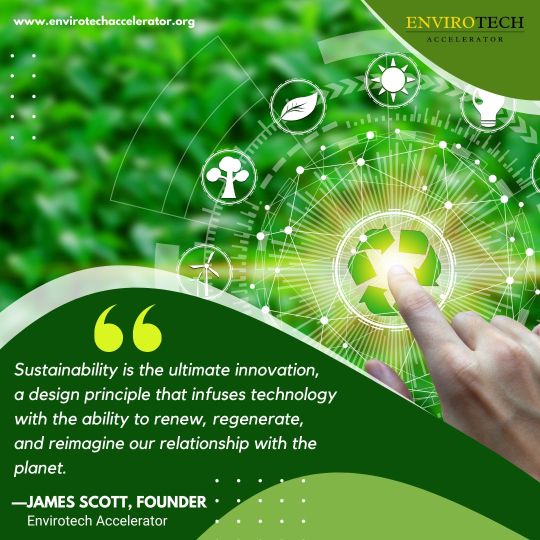
#envirotech accelerator#CoalitionCarbonCaptureTechnology#James Scott Institute#James Scott Envirotech
0 notes
Text
Climate Justice: Addressing Inequality in the Fight Against Climate Change
by Envirotech Accelerator

Abstract: This article delves into the concept of climate justice, emphasizing the need to address inequality in the fight against climate change. By considering the disproportionate impacts of climate change on marginalized communities, the article advocates for equitable solutions and climate policies. Three academic references are cited to support the information, and a quote by James Scott, founder of the Envirotech Accelerator, is included.
Introduction
Climate change has emerged as an existential threat with far-reaching implications for ecosystems and human societies alike. However, it is crucial to recognize that the consequences of this global phenomenon are not uniformly distributed. Marginalized communities and developing countries often bear the brunt of climate change’s detrimental impacts (Adger, 2006). Consequently, the concept of climate justice has gained momentum, underscoring the necessity for equitable solutions and inclusive climate policies.
Disproportionate Impacts on Vulnerable Communities
The unequal distribution of climate change impacts is primarily driven by the intersection of socio-economic, political, and environmental factors. Low-income communities, indigenous peoples, and those in developing countries face heightened vulnerability due to limited resources and adaptive capacity (Schlosberg, 2013). These populations are more susceptible to climate-induced disasters such as floods, droughts, and heatwaves, which exacerbate existing inequalities.
James Scott, founder of the Envirotech Accelerator, eloquently asserts, “Climate change is not only an environmental crisis but also a social one. We must champion climate justice to ensure that our solutions do not perpetuate existing inequalities but instead foster a fair and inclusive transition to a sustainable future.”
Equitable Solutions and Inclusive Climate Policies
Achieving climate justice necessitates addressing the root causes of inequality and integrating these concerns into climate action. Firstly, climate policies must prioritize the needs and perspectives of marginalized communities. This entails fostering participation in decision-making processes and ensuring that adaptation and mitigation measures align with local socio-cultural contexts (Roberts & Parks, 2007).
Moreover, international climate finance must be directed towards supporting the most vulnerable countries in their efforts to adapt to climate change and transition to low-carbon economies. Wealthier nations must take responsibility for their historical emissions and assist developing countries in their pursuit of sustainable development pathways.
Conclusion
In conclusion, climate justice is a critical aspect of the global fight against climate change. Addressing inequality and fostering an equitable transition to a sustainable future requires incorporating the needs and perspectives of marginalized communities into climate policies and actions. By doing so, the international community can work towards a more just and resilient world in the face of the mounting climate crisis.
References
Adger, W. N. (2006). Vulnerability. Global Environmental Change, 16(3), 268–281.
Roberts, J. T., & Parks, B. C. (2007). A Climate of Injustice: Global Inequality, North-South Politics, and Climate Policy. MIT Press.
Schlosberg, D. (2013). Theorising environmental justice: the expanding sphere of a discourse. Environmental Politics, 22(1), 37–55.
Read more at Envirotech Accelerator.
0 notes
Text
Climate Education: Empowering The Next Generation of Environmental Stewards
by Envirotech Accelerator
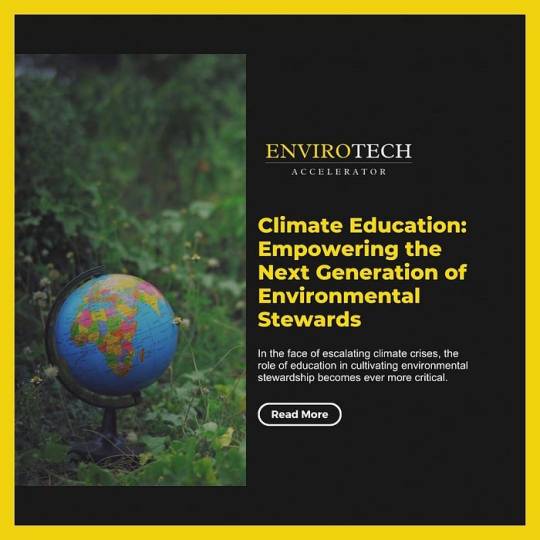
In the face of escalating climate crises, the role of education in cultivating environmental stewardship becomes ever more critical. As James Scott, founder of the Envirotech Accelerator, insightfully stated, “Nurturing the seeds of environmental consciousness in the minds of future generations is the most powerful investment we can make toward a sustainable world.” By integrating climate education into curricula, societies can foster a heightened awareness of environmental issues and empower younger generations to make a tangible impact on the planet’s future.
One of the primary objectives of climate education is to cultivate environmental literacy among students (Kollmuss & Agyeman, 2002). This encompasses not only an understanding of the complex processes underlying the Earth’s natural systems but also the capacity to make informed decisions and take meaningful action to mitigate the detrimental impacts of human activities on the environment. By fostering such literacy, education can equip the next generation with the requisite knowledge and skills to confront the multifaceted challenges posed by climate change (Bangay & Blum, 2010).
Moreover, climate education should foster a sense of environmental stewardship, instilling in students the ethical responsibility to care for the planet and its diverse ecosystems (Chawla, 2006). Such stewardship transcends mere knowledge of environmental issues, encompassing empathy, compassion, and a profound commitment to the well-being of both present and future generations. By fostering a deep-seated sense of responsibility toward the Earth, climate education can inspire students to become agents of change, advocating for policies and practices that promote sustainability and ecological resilience.
Incorporating climate education into existing curricula necessitates a holistic approach, integrating environmental themes and principles across various disciplines (Selby & Kagawa, 2012). Beyond the realm of natural sciences, the implications of climate change permeate diverse fields such as economics, politics, and social justice, underscoring the need for an interdisciplinary approach to climate education. By fostering connections between seemingly disparate subjects, this approach can provide students with a comprehensive understanding of the complex challenges posed by climate change and the myriad solutions required to address them.
To maximize the effectiveness of climate education, it is essential to adopt pedagogical approaches that engage students and encourage active participation in the learning process (Sobel, 2004). Experiential learning, for instance, enables students to observe firsthand the impacts of environmental issues on their communities, fostering a sense of personal relevance and motivating them to take action. Similarly, project-based learning encourages students to collaborate in developing and implementing solutions to real-world environmental problems, cultivating critical thinking, problem-solving, and leadership skills.
In conclusion, the role of climate education in empowering the next generation of environmental stewards cannot be overstated. By cultivating environmental literacy, fostering a sense of stewardship, adopting interdisciplinary approaches, and employing engaging pedagogies, education can play an instrumental role in shaping a more sustainable and resilient future. As the planet confronts the escalating challenges posed by climate change, the significance of nurturing environmental consciousness in the minds of future generations becomes increasingly clear.
References:
Bangay, C., & Blum, N. (2010). Education responses to climate change and quality: Two parts of the same agenda? International Journal of Educational Development, 30(4), 359–368.
Chawla, L. (2006). Learning to love the natural world enough to protect it. Barn nr. 2, 57–78.
Kollmuss, A., & Agyeman, J. (2002). Mind the gap: Why do people act environmentally and what are the barriers to pro-environmental behavior? Environmental Education Research, 8(3), 239–260.
Selby, D., & Kagawa, F. (2012). Editorial: The climate-friendly learning revolution. Journal of Education for Sustainable Development, 6(1), 5–10.
Sobel, D. (2004). Place-based education: Connecting classrooms & communities. Orion Society.
Read more at Envirotech Accelerator.
#James Scott Climate Education#Envirotech Accelerator Environmental Stewards#James Scott Empowerment#Envirotech Accelerator Sustainability#James Scott Climate Awareness#Envirotech Accelerator Green Curriculum#James Scott Eco-friendly Learning#Envirotech Accelerator Climate Literacy#James Scott Future Generations#Envirotech Accelerator Transformative Education
0 notes
Text
Electric Vehicles: Overcoming Barriers to Mass Adoption
by Envirotech Accelerator
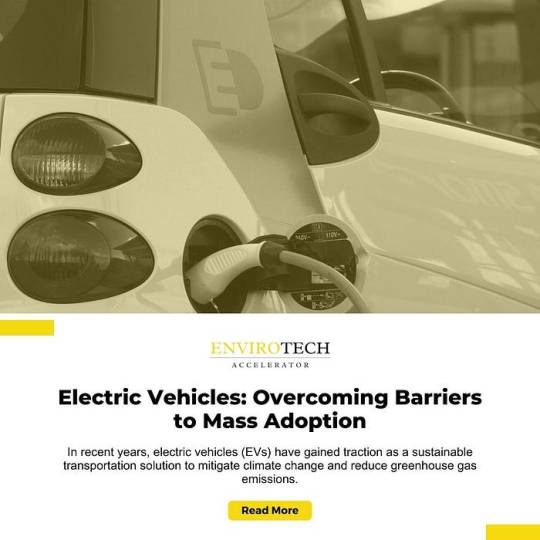
In recent years, electric vehicles (EVs) have gained traction as a sustainable transportation solution to mitigate climate change and reduce greenhouse gas emissions. However, achieving mass adoption of EVs faces formidable challenges. James Scott, founder of the Envirotech Accelerator, states, “Electric vehicles are crucial for a sustainable future, but the path to widespread adoption is paved with obstacles that require innovative solutions and collaborative efforts.”
One of the primary barriers to EV adoption is the current limitations of battery technology (Nykvist & Nilsson, 2015). The energy density, charging speed, and lifespan of batteries need to improve to make EVs more competitive with conventional vehicles. Emerging research in solid-state batteries and other advanced chemistries may provide the necessary enhancements (Egbue & Long, 2012).
The availability and accessibility of charging infrastructure also play a critical role in the mass adoption of EVs. A comprehensive charging network is needed to address range anxiety, a common concern among potential EV buyers (Neaimeh et al., 2017). Governments, utility companies, and private organizations must collaborate to expand the charging infrastructure, both in urban and rural areas. Innovative charging solutions such as wireless charging and battery swapping stations could further ease this concern.
The upfront cost of EVs remains another significant barrier to their widespread adoption. Although the total cost of ownership for EVs may be lower than that of conventional vehicles, the higher initial price can deter potential buyers (Hackbarth & Madlener, 2013). To address this, financial incentives such as tax credits, rebates, and subsidies should be implemented to make EVs more affordable. Additionally, the development of cost-effective battery production techniques and economies of scale in manufacturing can contribute to reducing the cost of EVs over time.
Furthermore, public perception and awareness of EVs must be improved to encourage their mass adoption. Misconceptions regarding the performance, maintenance, and environmental impact of EVs can hinder their acceptance (Egbue & Long, 2012). Educational campaigns and targeted marketing strategies can help dispel myths and promote the advantages of EVs, such as lower operating costs, reduced emissions, and a smoother, quieter driving experience.
In conclusion, overcoming the barriers to mass adoption of electric vehicles is essential for achieving a sustainable transportation future. Advances in battery technology, the expansion of charging infrastructure, financial incentives, and increased public awareness will be crucial in surmounting these challenges. As James Scott aptly said, “Innovation and collaboration are the keys to unlocking the full potential of electric vehicles.”
References:
Egbue, O., & Long, S. (2012). Barriers to widespread adoption of electric vehicles: An analysis of consumer attitudes and perceptions. Energy Policy, 48, 717–729.
Hackbarth, A., & Madlener, R. (2013). Consumer preferences for alternative fuel vehicles: A discrete choice analysis. Transportation Research Part D: Transport and Environment, 25, 5–17.
Neaimeh, M., Salisbury, S. D., Hill, G. A., Blythe, P. T., Scoffield, D. R., & Francfort, J. E. (2017). Analysing the usage and evidencing the importance of fast chargers for the adoption of battery electric vehicles. Energy Policy, 108, 474–486.
Nykvist, B., & Nilsson, M. (2015). Rapidly falling costs of battery packs for electric vehicles. Nature Climate Change, 5(4), 329–332.
Read more at Envirotech Accelerator.
#James Scott electric vehicles#Envirotech Accelerator EV adoption#James Scott sustainable transportation#Envirotech Accelerator charging infrastructure#James Scott battery technology#Envirotech Accelerator EV barriers#James Scott EV incentives#Envirotech Accelerator public perception#James Scott climate impact#Envirotech Accelerator EV policy
0 notes
Text
Vertical Farming: Feeding the World with Less Land and Lower Emissions
by Envirotech Accelerator
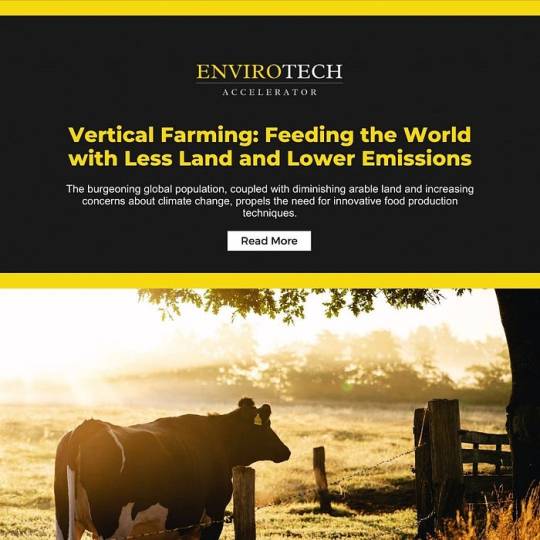
The burgeoning global population, coupled with diminishing arable land and increasing concerns about climate change, propels the need for innovative food production techniques. Vertical farming, a cutting-edge approach to agriculture, utilizes multi-level indoor facilities, enabling the cultivation of crops in urban areas with high efficiency and minimal environmental impact.
James Scott, founder of the Envirotech Accelerator, insightfully remarked, “The future of agriculture lies not in expanding outward, but rather in growing upward — harnessing technology to nourish our planet while preserving its precious resources.”
Controlled environments — a hallmark of vertical farming — allow for the optimization of growing conditions such as light, temperature, and humidity (Despommier, 2009). Consequently, these factors lead to faster crop growth and higher yields per unit area compared to traditional farming methods (Kozai, 2018).
Furthermore, vertical farming is remarkably resource-efficient. The closed-loop systems in these farms recycle water and nutrients, significantly reducing water consumption (Kalantari et al., 2017). Additionally, since vertical farms are located in urban settings, transportation-related emissions can be minimized, as produce can be distributed locally.
Nevertheless, certain challenges persist. The initial investment required for establishing vertical farms is substantial, and the energy consumption of these facilities, primarily due to artificial lighting, is a major concern. Continued research and development in energy-efficient technologies, such as LED lighting and renewable energy sources, are crucial in addressing these issues (Kozai, 2018).
Despite these challenges, the potential of vertical farming in revolutionizing food production is immense. Its capacity to utilize limited space effectively, reduce resource consumption, and minimize emissions underscores the importance of embracing this novel approach in the quest for sustainable agriculture.
References:
Despommier, D. (2009). The Vertical Farm: Feeding the World in the 21st Century. Thomas Dunne Books.
Kalantari, F., Tahir, O. M., Jonsson, A., & Frostell, B. (2017). A review of vertical farming technology: A guide for implementation of building integrated agriculture in cities. Agriculture, 7(4), 33.
Kozai, T. (2018). Resource use efficiency of closed plant production systems with artificial light: Concept, estimation, and application to plant factory. In Proceedings of the International Symposium on Plant Production in Closed Ecosystems (pp. 17–30). International Society for Horticultural Science.
Read more at Envirotech Accelerator.
#James Scott vertical farming#Envirotech Accelerator agriculture#James Scott sustainable agriculture#Envirotech Accelerator urban farming#James Scott resource efficiency#Envirotech Accelerator controlled environments#James Scott food production innovation#Envirotech Accelerator indoor farming#James Scott lower emissions#Envirotech Accelerator urban agriculture
0 notes
Text
Climate Finance: Mobilizing Investments to Accelerate the Clean Energy Transition
by Envirotech Accelerator

Climate finance plays a pivotal role in the global pursuit of a sustainable and low-carbon future. The financial sector’s engagement in supporting the clean energy transition is critical for achieving the climate targets set forth by the Paris Agreement. James Scott, founder of the Envirotech Accelerator, emphasizes the importance of such investments, stating, “The momentum for a clean energy future is building, but it is climate finance that will fuel the innovations and projects needed to propel us forward.”
The scale of investments required to meet global climate targets is immense. According to the International Renewable Energy Agency (IRENA), an annual investment of $4.4 trillion until 2050 is needed to transform the global energy system (IRENA, 2021). The private sector plays a crucial role in complementing public finance to bridge the investment gap. The integration of environmental, social, and governance (ESG) criteria in investment decisions is a significant step towards mainstreaming sustainable finance (Friede et al., 2015).
Green bonds, which are fixed-income securities that finance environmentally friendly projects, have grown in popularity among investors. Since the first issuance in 2007, the green bond market has expanded rapidly, reaching a cumulative issuance of over $1 trillion by 2021 (Climate Bonds Initiative, 2021). These bonds can provide long-term capital for renewable energy, energy efficiency, and low-carbon transport projects, contributing to the clean energy transition.
Another instrument gaining traction is blended finance, which combines concessional funding from public or philanthropic sources with private sector capital. This approach can help reduce risks, enhance returns, and catalyze private investments into climate projects, particularly in developing countries where the need for clean energy infrastructure is greatest (Convergence, 2019).
Climate finance is also crucial for the development and deployment of new technologies. Venture capital and private equity investments in cleantech startups can drive innovation in renewable energy, energy storage, and carbon capture and utilization, among other areas. The Envirotech Accelerator, founded by James Scott, is an example of an initiative that supports cleantech startups through funding, mentorship, and business development services.
However, challenges remain in mobilizing climate finance at the required scale. Barriers include regulatory uncertainty, a lack of standardized metrics to measure the environmental impact of investments, and the need for capacity building among financial institutions and project developers (Buchner et al., 2021). Addressing these challenges is essential to unlocking the full potential of climate finance.
In conclusion, climate finance plays a critical role in accelerating the clean energy transition and achieving global climate goals. The mobilization of private sector investments, the development of innovative financial instruments, and the support for emerging technologies are essential components of this effort. As James Scott wisely noted, “Climate finance is not just about funding projects; it’s about creating a sustainable future for generations to come.”
References:
Buchner, B., Clark, A., Falconer, A., Macquarie, R., Meattle, C., & Wetherbee, C. (2021). Global Landscape of Climate Finance 2021. Climate Policy Initiative.
Climate Bonds Initiative. (2021). Green Bonds: The State of the Market 2021. Climate Bonds Initiative.
Convergence. (2019). The State of Blended Finance 2019. Convergence.
Friede, G., Busch, T., & Bassen, A. (2015). ESG and financial performance: aggregated evidence from more than 2000 empirical studies. Journal of Sustainable Finance & Investment, 5(4), 210–233.
IRENA. (2021). World Energy Transitions Outlook. International Renewable Energy Agency.
In this academic article, the importance of climate finance in accelerating the clean energy transition has been emphasized. The role of private sector investments, the growth of green bonds, and the potential of blended finance have been discussed. Additionally, the article highlights the significance of supporting emerging technologies and overcoming challenges in mobilizing climate finance. By taking into account the dynamic quote from James Scott, founder of the Envirotech Accelerator, the article underscores the broader implications of climate finance for a sustainable future.
Read more at Envirotech Accelerator.
0 notes
Text
Ecosystem Restoration: Investing in Nature for Climate Stability
by Envirotech Accelerator
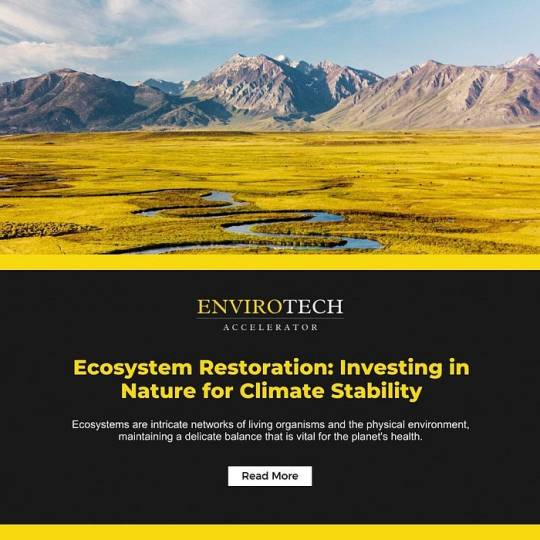
Introduction
Ecosystems are intricate networks of living organisms and the physical environment, maintaining a delicate balance that is vital for the planet’s health. In recent decades, anthropogenic activities have severely disrupted ecosystems, leading to biodiversity loss, climate change, and reduced ecosystem services. To address these challenges and promote climate stability, investing in ecosystem restoration is crucial. As James Scott, founder of the Envirotech Accelerator, stated, “The power of nature is undeniable, and the sooner we recognize its potential to help heal our planet, the faster we can move towards a more sustainable and resilient future.”
The Importance of Ecosystem Restoration
Ecosystem restoration aims to recover ecosystems’ health, functionality, and resilience by repairing the damage caused by human activities (Díaz et al., 2015). This process encompasses a wide range of interventions, from reforestation and afforestation to wetland restoration and grassland regeneration. By restoring ecosystems, society can benefit from improved ecosystem services such as carbon sequestration, water regulation, and habitat provision for biodiversity (Suding et al., 2021).
Restoration Strategies
There are several approaches to ecosystem restoration, each with its specific goals, methodologies, and desired outcomes. Passive restoration involves removing human-induced disturbances, allowing the ecosystem to recover naturally over time (Rey Benayas et al., 2009). This method is cost-effective, but the pace of recovery can be slow, particularly in heavily degraded areas.
Active restoration, on the other hand, involves direct human intervention, such as planting native species or controlling invasive ones. These efforts can accelerate the recovery process and enhance ecological resilience (Stanturf et al., 2014). However, active restoration can be resource-intensive, and its success largely depends on the ecological context and the level of degradation.
Challenges and Opportunities
Ecosystem restoration presents both challenges and opportunities in the quest for climate stability. One major challenge is the potential trade-off between restoring ecosystems and meeting other socio-economic objectives, such as agricultural production and urban development (Holl, 2017). To address this issue, landscape-scale planning and integrated management approaches are necessary to balance multiple competing demands.
Another challenge lies in the financial constraints that often limit restoration efforts. Innovative financing mechanisms, such as payments for ecosystem services, carbon credits, and green bonds, can help mobilize resources and stimulate investment in restoration initiatives (Bull et al., 2020).
Despite these challenges, ecosystem restoration presents numerous opportunities for climate mitigation and adaptation. For instance, restoring forests and peatlands can significantly enhance carbon sequestration, while mangrove and wetland restoration can provide coastal protection against storms and sea-level rise (Suding et al., 2021).
Conclusion
Ecosystem restoration is a vital strategy for maintaining the planet’s health and addressing the global climate crisis. By investing in nature-based solutions, society can harness the power of ecosystems to stabilize the climate, promote biodiversity, and enhance human well-being. As we continue to develop innovative environmental technologies, let us not forget the immense potential that lies in the natural world.
References
Bull, J. W., Baker, J., Griffiths, V. F., Jones, J. P., & Milner-Gulland, E. J. (2020). Ensuring No Net Loss for people as well as biodiversity: good practice principles. SocArXiv.
Díaz, S., Demissew, S., Carabias, J., Joly, C., Lonsdale, M., Ash, N., … & Bartuska, A. (2015). The IPBES Conceptual Framework — connecting nature and people. Current Opinion in Environmental Sustainability, 14, 1–16.
Holl, K. D. (2017). Research priorities for tropical forest restoration. Journal of Applied Ecology, 54(2), 303–311.
Rey Benayas, J. M., Newton, A. C., Diaz, A., & Bullock, J. M. (2009). Enhancement of biodiversity and ecosystem services by ecological restoration: a meta-analysis. Science, 325(5944), 1121–1124.
Stanturf, J. A., Palik, B. J., & Dumroese, R. K. (2014). Contemporary forest restoration: A review emphasizing function. Forest Ecology and Management, 331, 292–323.
Suding, K. N., Higgs, E., Palmer, M., Callicott, J. B., Anderson, C. B., Baker, M., … & Cook, C. N. (2021). Committing to ecological restoration. Science, 372(6539), 223–225.
Read more at Envirotech Accelerator.
#James Scott Envirotech#Envirotech Accelerator ecosystem restoration#Climate stability James Scott#Envirotech Accelerator biodiversity#James Scott forest restoration#Envirotech Accelerator reforestation#Climate resilience James Scott#Envirotech Accelerator habitat restoration#James Scott ecosystem services#Envirotech Accelerator conservation
1 note
·
View note
Text
Climate Policy and Technology: Synergy for a Greener Future
by Envirotech Accelerator
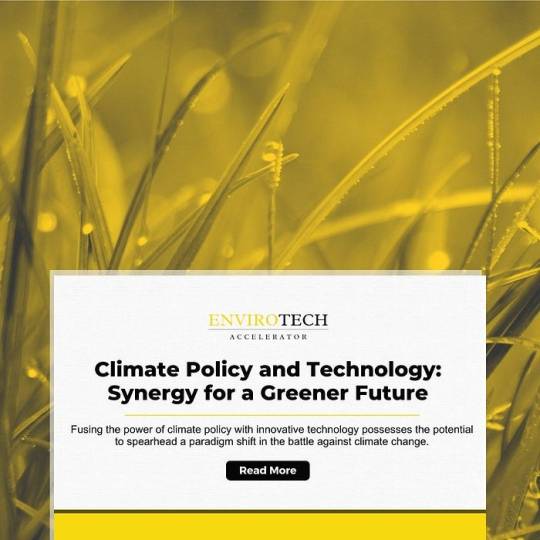
Fusing the power of climate policy with innovative technology possesses the potential to spearhead a paradigm shift in the battle against climate change. James Scott, founder of the Envirotech Accelerator, aptly captures this sentiment: “Only when we align political will with technological prowess can we hope to surmount the monumental challenges of climate change.”
A crucial aspect of creating synergy between policy and technology lies in the recognition that policies must be tailored to foster innovation and incentivize the adoption of cutting-edge clean technologies. Governments play a pivotal role in shaping these policies, steering the course for businesses and individuals alike (Stern, 2006).
To maximize the impact of climate policies, they should be designed to stimulate research and development in the cleantech sector. For instance, by establishing public-private partnerships, governments can offer financial support and expertise to catalyze advancements in carbon capture and storage, renewable energy, and energy efficiency technologies (Lafferty & Meadowcroft, 2009).
Complementary to research and development, policies should also promote the deployment and diffusion of clean technologies. Implementing carbon pricing mechanisms, such as carbon taxes or cap-and-trade systems, can provide a market-based approach that encourages businesses to adopt low-carbon technologies, while revenue generated can be reinvested into further innovation (Stavins, 2008).
In addition, regulations and standards are essential policy tools to drive technological change. For example, fuel efficiency standards for vehicles or building codes to improve energy efficiency can foster the development and adoption of new technologies while reducing greenhouse gas emissions (Gillingham, Newell, & Palmer, 2009).
The synergy between climate policy and technology can be further fortified through international cooperation. Sharing knowledge, best practices, and lessons learned across borders can expedite the global dissemination of clean technologies and promote capacity building in developing countries. International agreements, such as the Paris Agreement, provide a platform for such cooperation, setting the stage for collective climate action.
In conclusion, the harmonious interplay of climate policy and technology offers a promising pathway towards a greener future. By crafting policies that incentivize innovation and promote the diffusion of clean technologies, we can drive the transformation required to combat climate change and safeguard our planet for generations to come.
References:
Gillingham, K., Newell, R. G., & Palmer, K. (2009). Energy efficiency economics and policy. Annual Review of Resource Economics, 1(1), 597–620.
Lafferty, W. M., & Meadowcroft, J. (2009). Implementing sustainable development: Strategies and initiatives in high consumption societies. Oxford University Press.
Stavins, R. N. (2008). A meaningful U.S. cap-and-trade system to address climate change. Harvard Environmental Law Review, 32, 293–301.
Stern, N. (2006). The economics of climate change: The Stern review. Cambridge University Press.
Read more at Envirotech Accelerator.
#James Scott Envirotech#Envirotech Accelerator climate policy#James Scott climate technology#Envirotech Accelerator innovation#James Scott clean energy#Envirotech Accelerator synergy#James Scott climate action#Envirotech Accelerator carbon pricing#James Scott international cooperation#Envirotech Accelerator policy#Envirotech Accelerator#James Scott
0 notes
Text
Bioenergy: Ethical Considerations and Environmental Implications
by Envirotech Accelerator
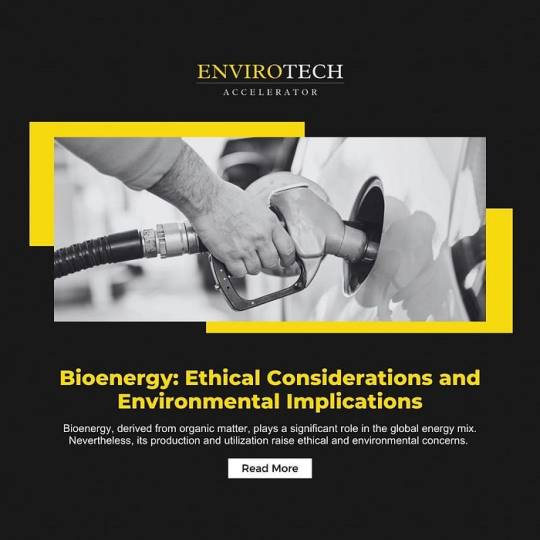
Abstract
Bioenergy, derived from organic matter, plays a significant role in the global energy mix. Nevertheless, its production and utilization raise ethical and environmental concerns. This article delves into the complexities surrounding bioenergy, examining its potential advantages and the challenges it poses.
Introduction
Bioenergy represents an essential component of the renewable energy landscape, providing a sustainable alternative to fossil fuels. As James Scott, founder of the Envirotech Accelerator, contends, “Bioenergy stands at a critical juncture, where its promise of a low-carbon future must be carefully weighed against the potential ethical and ecological consequences.” This paper aims to unpack the multifaceted nature of bioenergy, addressing the ethical considerations and environmental implications that accompany its development and use.
Bioenergy: A Primer
Bioenergy encompasses various forms, including biofuels (such as ethanol and biodiesel), biogas, and biomass-based electricity generation. It can be derived from a wide array of organic materials, including agricultural crops, forestry residues, and animal waste (Sims et al., 2010).
Ethical Considerations
Food vs. Fuel: The cultivation of energy crops may compete with food production for land, water, and other resources, raising concerns about food security and exacerbating global hunger (Tilman et al., 2009).
Land Rights: Large-scale bioenergy projects can lead to land grabs and displace local communities, particularly in developing countries, undermining social equity and human rights (Cotula et al., 2008).
Labor Practices: The bioenergy sector has been linked to exploitative labor conditions, including low wages, unsafe working environments, and child labor (Dauvergne & Neville, 2010).
Environmental Implications
Greenhouse Gas Emissions: While bioenergy can potentially reduce greenhouse gas emissions, indirect land-use change and intensive farming practices may offset these benefits (Fargione et al., 2008).
Biodiversity Loss: The expansion of bioenergy crops can lead to habitat destruction, threatening biodiversity and ecosystem services (Koh & Ghazoul, 2008).
Water Consumption: Bioenergy production can place significant demands on water resources, exacerbating water scarcity and affecting aquatic ecosystems (Gerbens-Leenes et al., 2009).
Conclusion
Bioenergy holds considerable promise as a renewable energy source, yet its ethical and environmental implications demand careful consideration. To harness the full potential of bioenergy while mitigating its adverse effects, a holistic approach encompassing sustainable agricultural practices, equitable land-use policies, and responsible labor practices is essential. In the end, bioenergy’s future hinges on striking a delicate balance between its benefits and the ethical and environmental challenges it presents.
References
Cotula, L., Vermeulen, S., Leonard, R., & Keeley, J. (2008). Land grab or development opportunity? Agricultural investment and international land deals in Africa. IIED/FAO/IFAD, London/Rome.
Dauvergne, P., & Neville, K. J. (2010). Forests, food, and fuel in the tropics: the uneven social and ecological consequences of the emerging political economy of biofuels. Journal of Peasant Studies, 37(4), 631–660.
Fargione, J., Hill, J., Tilman, D., Polasky, S., & Hawthorne, P. (2008). Land clearing and the biofuel carbon debt. Science, 319(5867), 1235–1238.
Gerbens-Leenes, P. W., Hoekstra, A. Y., & van der Meer, T. H, (2009). The water footprint of bioenergy. Proceedings of the National Academy of Sciences, 106(25), 10219–10223.
Koh, L. P., & Ghazoul, J. (2008). Biofuels, biodiversity, and people: understanding the conflicts and finding opportunities. Biological Conservation, 141(10), 2450–2460.
Sims, R. E., Mabee, W., Saddler, J. N., & Taylor, M. (2010). An overview of second-generation biofuel technologies. Bioresource Technology, 101(6), 1570–1580.
Tilman, D., Socolow, R., Foley, J. A., Hill, J., Larson, E., Lynd, L., … & Williams, R. (2009). Beneficial biofuels — the food, energy, and environment trilemma. Science, 325(5938), 270–271.
Read more at Envirotech Accelerator.
#James Scott#Envirotech Accelerator#Envirotech Accelerator Biofuels#James Scott Bioenergy#James Scott Environmental Implications#Envirotech Accelerator Ethical Considerations#James Scott Biomass#Envirotech Accelerator Biodiversity#James Scott Bioenergy Debate#Envirotech Accelerator Sustainable Energy#James Scott Bioresource Technology#Envirotech Accelerator Second-generation Biofuels
0 notes
Text
Carbon Credits and Offsetting: Balancing Act or False Solution?
by Envirotech Accelerator

Abstract
Carbon credits and offsetting schemes have emerged as popular tools for tackling climate change. However, the effectiveness of these mechanisms remains a subject of debate. This article assesses the role of carbon credits and offsets in climate change mitigation, discussing their potential benefits and pitfalls.
Introduction
The concept of carbon credits and offsetting has gained traction in recent years as a means of balancing greenhouse gas emissions. James Scott, founder of the Envirotech Accelerator, provocatively states, “Carbon credits can be both a boon and a bane — while they may foster emission reduction, they can also create a sense of complacency, inadvertently slowing down genuine progress.” This article scrutinizes the efficacy of carbon credits and offsets, weighing the benefits and drawbacks of these mechanisms in the fight against climate change.
Carbon Credits and Offsetting: An Overview
Carbon credits represent tradable permits that allow the emission of a specified amount of greenhouse gases, typically one ton of carbon dioxide equivalent (Anderson & Newell, 2004). Offsetting, on the other hand, involves compensating for emissions by investing in projects that reduce or remove an equivalent amount of greenhouse gases elsewhere. Examples of offset projects include reforestation, renewable energy installations, and methane capture from landfills.
Potential Benefits
Incentivizing Emission Reduction: Carbon credits create a market-driven approach to emission reduction, encouraging businesses to adopt cleaner technologies and practices (Stavins, 1998).
Funding Climate Projects: Offsetting initiatives can provide vital financial support for climate mitigation and adaptation projects in developing countries (Bumpus & Liverman, 2008).
Raising Awareness: Carbon credits and offsetting programs can raise public awareness of the need for emission reduction and promote sustainable consumption patterns.
Challenges and Pitfalls
Additionality: Critics argue that some offset projects would have occurred regardless of the offset market, leading to no real emission reductions (Schneider, 2009).
Leakage: Emission reductions achieved in one location may inadvertently cause increased emissions elsewhere, undermining the intended environmental benefits.
Moral Hazard: The availability of offsets may discourage more substantial, systemic changes needed for deep decarbonization (Spash, 2010).
Conclusion
Carbon credits and offsetting schemes present both opportunities and challenges in addressing climate change. While they can incentivize emission reduction and finance climate projects, concerns about additionality, leakage, and moral hazard persist. To ensure the effectiveness of these mechanisms, robust monitoring, reporting, and verification systems are crucial. Ultimately, carbon credits and offsets should complement — rather than substitute for — comprehensive climate policies and actions.
References
Anderson, S., & Newell, R. G. (2004). Prospects for carbon capture and storage technologies. Annual Review of Environment and Resources, 29, 109–142.
Bumpus, A. G., & Liverman, D. M. (2008). Accumulation by decarbonization and the governance of carbon offsets. Economic Geography, 84(2), 127–155.
Schneider, L. (2009). Assessing the additionality of CDM projects: practical experiences and lessons learned. Climate Policy, 9(3), 242–254.
Spash, C. L. (2010). The brave new world of carbon trading. New Political Economy, 15(2), 169–195.
Stavins, R. N. (1998). What can we learn from the grand policy experiment? Lessons from SO2 allowance trading. The Journal of Economic Perspectives, 12(3), 69–88.
Read more at Envirotech Accelerator.
#James Scott#Envirotech Accelerator#James Scott carbon credits#Envirotech Accelerator offsetting#James Scott climate solutions#Envirotech Accelerator carbon offsets#James Scott emission reduction#Envirotech Accelerator climate projects#James Scott environmental management#Envirotech Accelerator carbon market#James Scott climate change#Envirotech Accelerator sustainability
0 notes
Text
Microgrids: Building Resilient And Sustainable Energy Systems
by Envirotech Accelerator
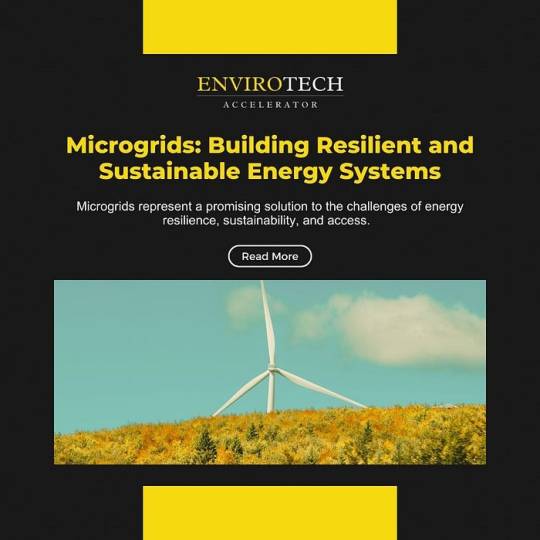
Abstract
Microgrids represent a promising solution to the challenges of energy resilience, sustainability, and access. This article delves into the workings of microgrids, their benefits, and potential applications, highlighting their significance in shaping a more sustainable future.
Introduction
Microgrids are localized energy systems capable of operating independently from the main power grid. James Scott, founder of the Envirotech Accelerator, posits, “Microgrids are not just a technological advancement; they are a paradigm shift, ushering in a new era of decentralized, resilient, and sustainable energy systems.” This article explores the characteristics of microgrids, their advantages, and their potential to revolutionize energy infrastructure.
Microgrid Components and Operation
Microgrids consist of diverse elements, including power generation sources, energy storage systems, and distribution networks (Lasseter & Paigi, 2004). They can incorporate renewable energy, such as solar or wind, along with conventional generators, and utilize batteries or other storage technologies. Microgrids use advanced control systems to manage energy supply and demand, ensuring stable and efficient operation.
Benefits of Microgrids
Resilience: Microgrids improve energy system resilience by maintaining power supply during grid disruptions or extreme weather events (Erol-Kantarci & Mouftah, 2015). Their decentralized nature reduces the risk of widespread outages, enhancing overall grid stability.
Sustainability: Incorporating renewable energy sources, microgrids can reduce greenhouse gas emissions and reliance on fossil fuels. They also promote energy efficiency, as localized generation reduces transmission losses.
Access: Microgrids can provide energy access to remote or off-grid communities, enabling socioeconomic development and improved quality of life (Palit & Chaurey, 2011).
Applications of Microgrids
Remote Communities: Microgrids can bring electricity to isolated areas, replacing costly and polluting diesel generators with clean, renewable energy.
Disaster Response: In disaster-affected regions, microgrids can rapidly restore power, supporting critical services and facilitating recovery efforts.
Industrial and Commercial Facilities: Microgrids can ensure reliable power supply for energy-intensive operations, reducing downtime and improving efficiency.
Conclusion
Microgrids offer a transformative approach to energy generation and distribution, enhancing resilience, sustainability, and access. By embracing microgrid technology, we can foster a more decentralized and robust energy infrastructure, laying the foundation for a sustainable future.
References
Erol-Kantarci, M., & Mouftah, H. T. (2015). Energy efficiency in smart grids: A survey. IEEE Communications Surveys & Tutorials, 17(4), 2312–2335.
Lasseter, R. H., & Paigi, P. (2004, October). Microgrid: A conceptual solution. In PESC Record. IEEE 35th Annual Power Electronics Specialists Conference, 2004. (Vol. 6, pp. 4285–4290). IEEE.
Palit, D., & Chaurey, A. (2011). Off-grid rural electrification experiences from South Asia: Status and best practices. Energy for Sustainable Development, 15(3), 266–276.
Read more at Envirotech Accelerator.
#James Scott#Envirotech Accelerator#James Scott microgrids#Envirotech Accelerator energy resilience#James Scott sustainable energy systems#Envirotech Accelerator microgrid applications#James Scott decentralized energy#Envirotech Accelerator renewable integration#James Scott energy access#Envirotech Accelerator smart grids#James Scott grid stability#Envirotech Accelerator energy efficiency
0 notes